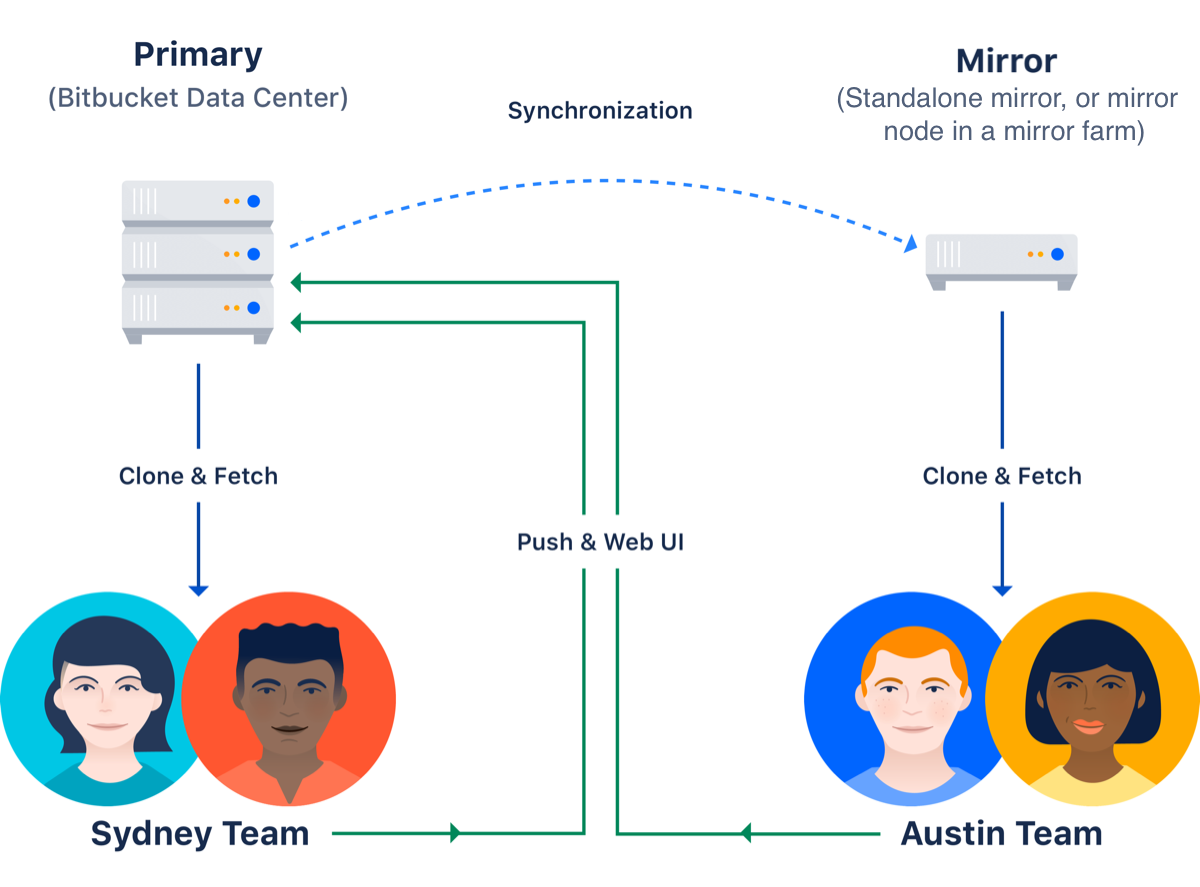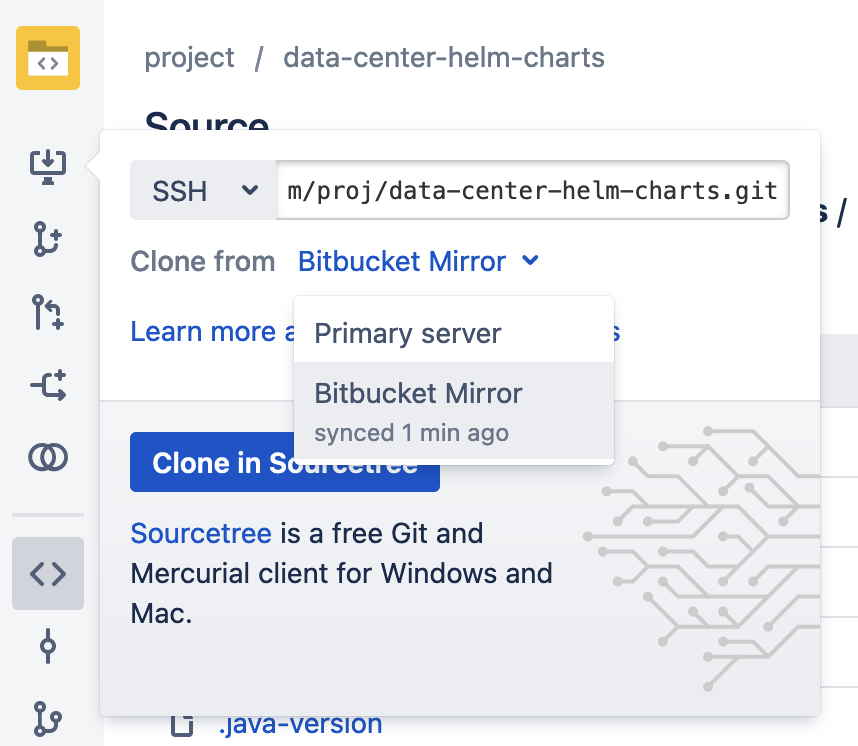Smart Mirroring ¶
Smart Mirroring can greatly improve Git clone speeds for distributed teams working with large repositories. Large repositories that take hours to clone from a Bitbucket instance over the Internet from the other side of the world can take minutes when cloned from a local mirror on a fast network.

You can learn more details about smart mirroring on the official documentation page.
Upstream/Primary instance
Primary instance is sometimes called upstream instance.
Requirements ¶
Primary instance prerequisites
Your primary Bitbucket instance must be a fully licensed Bitbucket Data Center instance
You do not have to run your Bitbucket Data Center instance as a multi-node cluster to use smart mirroring, but you must have an up-to-date Data Center license.
The primary instance and all mirror(s) must have HTTPS with a valid (i.e., signed by a Certificate Authority anchored to the root and not expired) SSL certificate
This is a strict requirement of smart mirroring on both the primary instance and all mirror(s), and cannot be bypassed. The mirror setup wizard will not proceed if either the mirror or the primary instance does not have a valid SSL certificate.
The primary Bitbucket instance must have SSH enabled
Mirrors keep their repositories synchronized with the primary instance over SSH and cannot use HTTP or HTTPS for this. See Enable SSH access to Git repositories for instructions on enabling SSH access on your primary instance.
Installation ¶
Overview ¶
- Install the primary as usual with Bitbucket Helm chart.
- You need to make sure the instance complies with all the above listed requirements.
- Install the mirror with second Bitbucket Helm chart.
- There is a set of properties that need to be configured to make the mirror work.
- Approve the mirror in the primary instance.
Steps ¶
Mirror Farm installation in Kubernetes ¶
Info
Example is using nginx-ingress controller. If you are using a different ingress controller, you will need to modify the example.
- Install the primary as usual with Bitbucket Helm chart.
- You need to make sure the instance complies with all the above listed requirements.
- Verify that you are able to clone from the primary via SSH protocol.
- Verify that primary instance is accessible over HTTPS with a valid SSL certificate.
- Create a new file
values-mirror.yamlwith the following content:bitbucket: mode: mirror displayName: Bitbucket Mirror clustering: enabled: true applicationMode: "mirror" mirror: upstreamUrl: <https url of the primary> # for example https://bitbucket-upstream.example.com # nginx specific configuration ingress: create: true host: bitbucket-mirror.example.com annotations: cert-manager.io/issuer: "letsencrypt-prod" # Default issuer tlsSecretName: <secret with TLS private key> # E.g. tls-certificate-mirror # enables persistence for mirror data volumes: localHome: persistentVolumeClaim: create: true - Edit the file to change the placeholder values.
bitbucket.mirror.upstreamUrlingress.hostingress.tlsSecretName
- Install the mirror
helm install bitbucket-mirror atlassian-data-center/bitbucket -f values-mirror.yaml
Mirror farm authorization ¶
These steps are described in detail in official documentation.
- Visit the mirror URL (it might take a couple of minutes to come up)
- Click on Go to the primary server in the mirror UI. The link will take you to the administration section of the primary instance.

- Click Authorize next to the mirror

- Select which projects should be synchronized

- Wait for the projects to be synchronized

- Verify that the synchronized projects can be cloned from the mirror

Scaling the mirror farm ¶
As the mirror is deployed with all the fulfilled requirements for the Bitbucket Mirror Farm, you are able to scale the mirrors easily. To increase or decrease the size of the mirror farm:
helm upgrade --set replicaCount=<desired number of mirror nodes> \
--reuse-values \
<name of the release>
atlassian-data-center/bitbucket
Adding or removing additional mirror farms ¶
It is possible to connect multiple mirror farms to a single primary instance. This can be useful to improve local performance for geographically distributed teams.
To add a new mirror farm, follow the same steps that were necessary to connect the first mirror farm. This means installing another helm release and authenticating it in the administrator user interface.
To remove a mirror farm:
- Navigate to Mirrors administration section on the primary
- Select the mirror from the list
- Click Delete button
- Uninstall the deleted mirror helm release from the cluster
Troubleshooting ¶
You can find the most common errors in mirror configuration described in the official Bitbucket documentation.